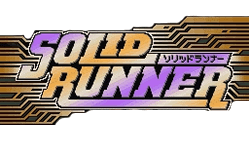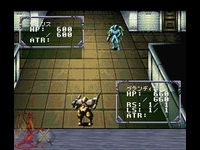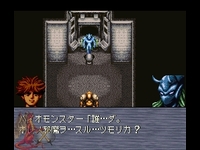|
|

|
PLATFORM
|
SNES
|
BATTLE SYSTEM
|

|
INTERACTION
|

|
ORIGINALITY
|

|
STORY
|

|
MUSIC & SOUND
|

|
VISUALS
|

|
CHALLENGE
|
Easy
|
COMPLETION TIME
|
Less than 20 Hours
|
|
OVERALL

|
+ Interesting setting and story (even in Japanese)
+ Many ways to customize the mech
- Enemies have too few attack patterns
- Encounter rate can be aggravating
|
Click here for scoring definitions
|
|
|
Early 1997 was not an auspicious time to release a new game on the Super Nintendo, especially in Japan where the PlayStation and Saturn had been out for over two years. ASCII took up the challenge and published Sting's second game, which unsurprisingly did not cross the Pacific given its RPG nature and North American publishers' movement away from the console. Solid Runner may not be a lost masterpiece that would have singlehandedly brought Super Nintendo sales up if it had been released in English, but it succeeds in being a mostly worthwhile game.
Solid Runner's setting is that of Solid City, located somewhere on Earth. Shu Askin is the protagonist, a military veteran well-versed in using a Runner for combat purposes. Runners are essentially combat mechs not much bigger than a human, and quite common in Solid City's seedier neighborhoods. Shu makes a living using his Runner on missions throughout the city as a bounty hunter of sorts. The first part of the story is concerned mostly with the encroachment of Bio Monsters that are beginning to attack the citizenry. When Shu's fiancée Eileen and her father are killed by Bavarians who seem to have a connection with that onslaught, vengeance becomes his overriding concern. The tale told is quite interesting, which makes the language barrier fairly annoying.
Shu cannot fight by himself, he must be in his Runner to do so. The Runner has four slots for equipment, two on the hands and two on the shoulders, with the hands and shoulders not being able to equip the same things. The variety of weapons available is substantial, and the player can experiment with them to find out whether a missile pod or a napalm launcher is best. Shopping for equipment is simple enough to do, since the changes each new weapon will offer are clearly displayed while cycling through the options.
Combat itself is always one-on-one. There is a tactical sensibility at play here, with three possible modes of attack, though the enemy and the player attack simultaneously. Projectiles can be used either while stationary or while moving, and some hand weapons use a charge to physically pummel the enemy. Each of the four weapons Shu has at his disposal is controlled via a different button to streamline menu usage, although the shoulder weapons may have to be reloaded. Shoulder weapons reload automatically after every battle, but if the player attempts to use one in a skirmish after its ammunition is exhausted, that turn will be spent reloading with no defensive measures possible.
 What's that enemy going to do? Will it ram or use a banshee wail?
What's that enemy going to do? Will it ram or use a banshee wail?
|
|
The combat is interesting and engaging whenever new enemies are encountered, but the AI lets the player down after awhile. Many enemies have only one attack pattern, making every encounter with them identical. Once the pattern is known, the player simply has to use the same strategy against that adversary every time to ensure victory with minimal damage. No single random adversary is a serious threat anyway, and so long as the player makes sure to take plenty of healing supplies along there is little risk of losing.
Leveling up is handled atypically in Solid Runner. Shu's statistics do rise once he has gained enough experience, but his Runner does not get any stronger automatically. Shu must speak with his friend Rif, the Runner's maintenance man, in order to do this. Each level gained by Shu allows the Runner to be upgraded a bit if Shu wants to pay for the assist, which is annoying at first but becomes less necessary as the game progresses. Money, by the way, is not gained from enemies (except by them dropping items to sell), but will be earned as a reward for completing missions.
 Bio Monsters usually aren't chatty, but some of them seem to have vocal chords and they let fly.
Bio Monsters usually aren't chatty, but some of them seem to have vocal chords and they let fly.
|
|
Visually Solid Runner looks decent enough, but in no way pushes the SNES. Palette swapped enemies are frequent, many dungeons look similar, and the animation could be better in battle. The sprites do show a lot of detail and many environments look good, but for 1997 the game looks unremarkable. The music is a mixed bag also. John Pee composed part of Treasure Hunter G's score the year before, and some of the music here is indeed quite catchy and atmospheric. Some of it is rather bland and uninteresting, but considering John Pee did not compose the entire soundtrack he should not be faulted.
There is relatively little optional content in Solid Runner to draw out the playing time, though at least one mission will vanish if it is not completed in a certain order. The game as a whole is fairly linear and has little replay incentive. It is also roughly twenty hours in length, though the final boss may draw that out a bit since it can be difficult to hit without grinding.
Solid Runner could have used some additional polish in its combat, but the game as it stands does not disgrace Sting's legacy. The details of the story will be difficult to comprehend for anyone without Japanese knowledge, which is a shame when this tale represents an enormous improvement over Sting's prior effort in Treasure Hunter G. The SNES import library is huge, and Solid Runner should not be at the top of anyone's list. However, those who seek out the less-explored titles will not be dismayed by this one.
Review Archives
|









